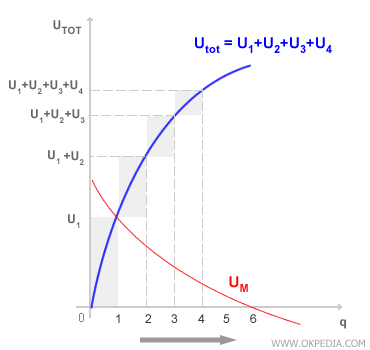Total Utility
Total utility is the overall satisfaction or benefit a person derives from consuming all the units of a good at a given point in time. According to the law of diminishing marginal utility and the principle of satiation, each additional unit of an economic good yields a lower level of utility than the previous one. The graph below shows the total utility U obtained from consuming n units of good X.

In the example above, the total utility (Utot) from consuming four units of good X equals the sum of the utilities derived from each unit consumed (U1 + U2 + U3 + U4). The utility gained from the first unit is referred to as the initial utility.


Total vs. Marginal Utility. Total utility and marginal utility behave in opposite ways as consumption increases. Total utility rises with the quantity (q) of the good consumed - as long as marginal utility remains positive. In contrast, marginal utility consistently declines with each additional unit consumed.
 Increasing Total Utility. Total utility continues to grow with the quantity consumed (q) only if the marginal utility of the last unit remains positive. Once the need is fully satisfied, further consumption leads to disutility - that is, negative utility - which ultimately reduces total utility. For example, in the previous case, the individual maximizes total utility at the sixth unit, when their need is completely met. Any consumption beyond the seventh unit generates negative utility (e.g., discomfort), thereby diminishing the individual’s total satisfaction.
Increasing Total Utility. Total utility continues to grow with the quantity consumed (q) only if the marginal utility of the last unit remains positive. Once the need is fully satisfied, further consumption leads to disutility - that is, negative utility - which ultimately reduces total utility. For example, in the previous case, the individual maximizes total utility at the sixth unit, when their need is completely met. Any consumption beyond the seventh unit generates negative utility (e.g., discomfort), thereby diminishing the individual’s total satisfaction.
